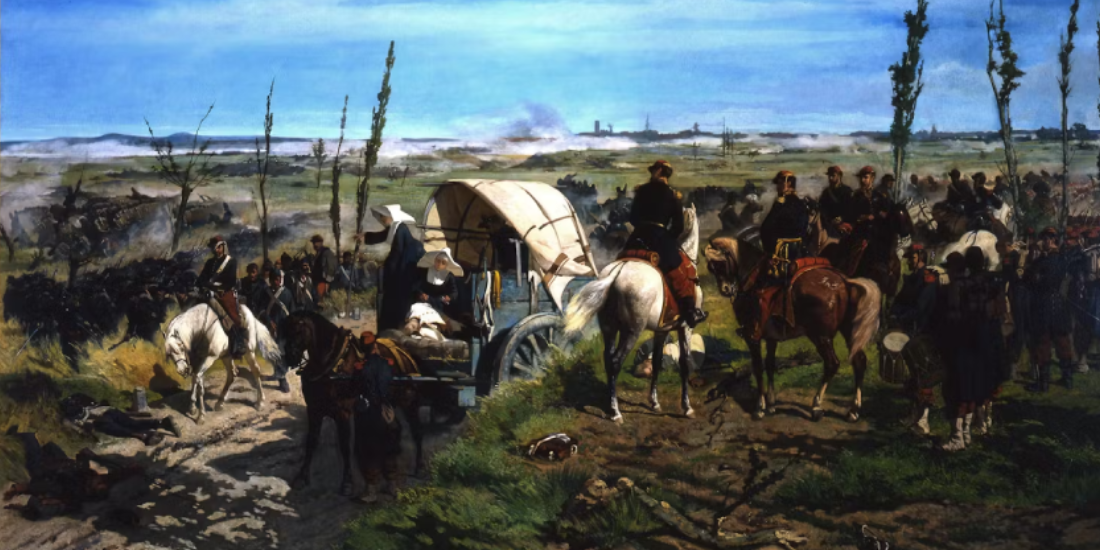
Italian Field after the Battle of Magenta by Giovanni Fattori: a human and sober portrait of the war during the Risorgimento
Jayde BrowneShare
Giovanni Fattori’s painting depicts a moving and truthful scene from the period immediately following the Battle of Magenta in 1859, during the Second Italian War of Independence. At the center, there is a cart pulled by two nurses, charitable sisters, who are accompanying a seriously wounded soldier. Beside them, other soldiers marked by suffering walk with difficulty, overseen by officers on horseback, while in the background the smoking outline of the town of Magenta, the site of the clash, is visible. The atmosphere is filled with dignity and compassion, far from heroic rhetoric, focusing instead on the human consequences of war, offering a quiet and reflective view of the suffering caused by the conflict.
BUY THE REPRODUCTION OF "ITALIAN FIELD AFTER THE BATTLE OF MAGENTA" BY GIOVANNI FATTORI

Style
The painting belongs to the early phase of the Macchiaioli movement, a group of Italian artists who distanced themselves from historical romanticism by focusing on patches and touches of color to capture reality and natural light more directly. Fattori uses this technique in a measured way, maintaining clear contours and a well-ordered composition that narrates the scene without ambiguity. Created in 1862, right in the heart of the Risorgimento period, the work avoids any nationalistic celebration in favor of emphasizing the humanity and physical and moral exhaustion of the soldiers, portraying the war as a raw and shared experience.
Color and Lighting
The palette prefers natural and subdued colors, with earthy tones and muted greens, interrupted by the white of the horse and the nurses’ garments. The sky is a vivid blue that contrasts with the battle-scarred landscape. Natural light gently illuminates the entire scene, without dramatic effects, creating a sober and contemplative atmosphere. The shadows are realistic and enhance the compact forms of the figures. The lighting guides the viewer’s gaze toward the cart and the wounded soldier, highlighting compassion without theatricality.
Management of Space
Depth is achieved through well-defined horizontal planes, where the figures in the foreground, the ranks of soldiers, and the landscape follow each other in balance. The perspective opens onto a wide horizon dominated by a bright sky, which breathes life and spaciousness into the scene. The elements are distributed harmoniously: on the right, the lined-up troops; on the left, the movement of the wounded; at the center, the cart symbolizing mercy. The compositional order conveys a sense of calm despite the wartime context.
Composition and Framing
The work presents a measured balance, with horizontal and diagonal lines gently guiding the eye during observation. The framing is frontal with a slight angle, allowing multiple narrative layers to be perceived: the nurses and the wounded soldier, the silent soldiers, and the battle’s smoke in the background. This choice gives harmony and allows for an intimate emotional participation by the viewer, focusing on human relationships and a shared sense of compassion.
Technique and Materials
Executed in oil on a large canvas (232 x 348 cm), the painting reveals Fattori’s skill in balancing precise details with broad areas of uniform color application, typical of the Macchiaioli style. The use of oil paint allows for a luminous but solid rendering, capable of maintaining sharpness and clarity in the figures and landscape without blurred edges. The technique represents a transitional phase between academic painting and the freer use of color patches, combining narrative clarity with a visual tactile effect that enhances the scene’s realism and suggestiveness.
This painting expresses the human experience of war with refined delicacy, setting aside heroic emphasis to offer a sincere and moving image of the fatigue and sacrifice of the Italian Risorgimento.
